

Keyhole Gardens. Keyhole Gardens First made popular in Africa, keyhole gardens are catching on in Texas and other hot, dry places.
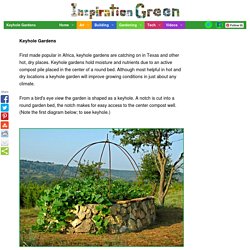
Keyhole gardens hold moisture and nutrients due to an active compost pile placed in the center of a round bed. Although most helpful in hot and dry locations a keyhole garden will improve growing conditions in just about any climate. From a bird's eye view the garden is shaped as a keyhole. A notch is cut into a round garden bed, the notch makes for easy access to the center compost well. Keyhole Garden in Central Texas, Deb Tolman uses keyhole gardens as the main source of her own food supply, and is working on ways to keep them producing throughout multiple seasons and conditions. Build a $300 underground greenhouse for year-round gardening (Video) Growers in colder climates often utilize various approaches to extend the growing season or to give their crops a boost, whether it's coldframes, hoop houses or greenhouses.
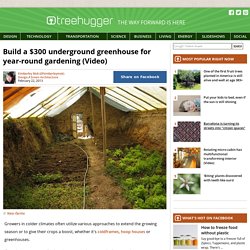
Greenhouses are usually glazed structures, but are typically expensive to construct and heat throughout the winter. A much more affordable and effective alternative to glass greenhouses is the walipini (an Aymara Indian word for a "place of warmth"), also known as an underground or pit greenhouse. First developed over 20 years ago for the cold mountainous regions of South America, this method allows growers to maintain a productive garden year-round, even in the coldest of climates.
Here's a video tour of a walipini that shows what a basic version of this earth-sheltered solar greenhouse looks like inside: © Benson Institute It's a pretty intriguing set-up that combines the principles of passive solar heating with earth-sheltered building. SilverThunder/via. Feed-in Tariff in Ireland « QRS Renewables. This “feed-in tariff” (also known as REFIT, the Renewable Energy Feed-In Tariff or export price) will be available for up to 4,000 micro-generation units for a period of three years, starting in 2009.
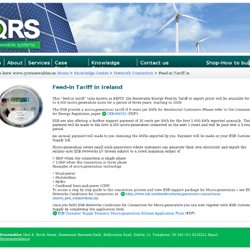
The ESB provide a micro-generation tariff of 9 cents per kWh for Residential Customers (Please refer to the Commission for Energy Regulation paper CER/09/033 (PDF)). ESB are also offering a further support payment of 10 cents per kWh for the first 3,000 kWh exported annually. This payment will be made to the first 4,000 micro-generators connected in the next 3 years and will be paid over a 5 year period.
An annual payment will made to you itemising the kWhs exported by you. Payment will be made on your ESB Customer Supply bill. Micro-generation covers small scale generators where customers can generate their own electricity and export the surplus onto ESB Networks LV System subject to a rated maximum output of: √ 6kW when the connection is single phase √ 11kW when the connection is three phase. Connect a Micro-Generator : ESB Networks. This page explains how to connect a micro-generator to the electricity network.
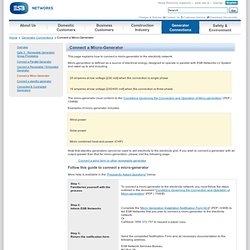
Micro-generation is defined as a source of electrical energy, designed to operate in parallel with ESB Networks LV System and rated up to and including: 25 amperes at low voltage [230 volt] when the connection is single phase 16 amperes at low voltage [230/400 volt] when the connection is three phase The micro-generator must conform to the 'Conditions Governing the Connection and Operation of Micro-generation' (PDF | 154KB) Examples of micro-generator includes: Wind-power Solar-power Micro combined heat-and-power (CHP) Note that standby generators cannot be used to sell electricity to the electricity grid. Connect a wind farm or other renewable generator Follow this guide to connect a micro-generator More help is available in the "Frequently Asked Questions" below. Recovered EarthShips. Imagine living in a house built out of tin cans, tires and other various recycled materials.
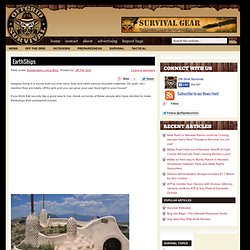
Oh yeah, did I mention they are totally off the grid and you can grow your own food right in your house? If you think that sounds like a good way to live, check out some of these people who have decided to make Earthships their permanent homes. Additional Information & Resources: Earthship Biotecture. Low impact living initiative. Lammas Home Page. A Low Impact Woodland Home.